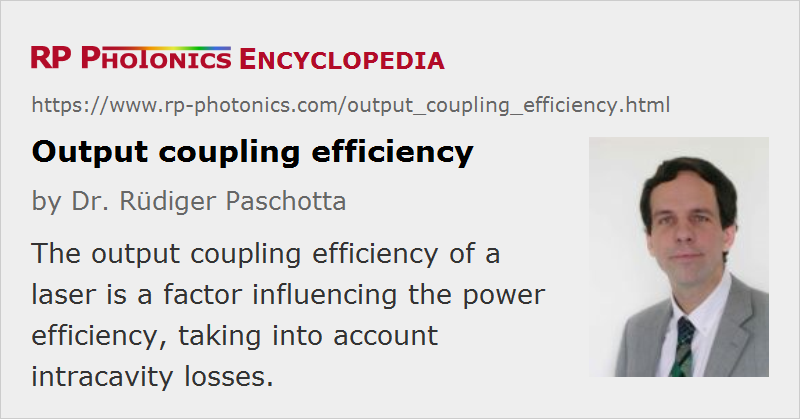Output Coupling Efficiency
Definition: a factor influencing the power efficiency of a laser, taking into account intracavity losses
German: Auskoppeleffizienz
Formula symbol: ηoc
Units: %, dimensionless number
How to cite the article; suggest additional literature
Author: Dr. Rüdiger Paschotta
Unavoidable parasitic intracavity losses in the resonator of a laser tend to reduce the laser's power efficiency. More specifically, they can increase the threshold pump power and reduce the slope efficiency. The sensitivity of the slope efficiency to intracavity losses depends on the transmission of the output coupler mirror: the larger this transmission, the lower is the circulating intracavity power, and the lower is the effect of intracavity losses. The output coupling efficiency is defined as the ratio of the useful losses to the total losses:
Here, the useful losses are given by the output coupler transmission Toc (or twice that value, if the output coupler is a folding mirror in a linear resonator), and the total losses contain both the useful losses and the parasitic losses lpar. This means that a larger output coupler transmission increases the output coupling efficiency; however, it also increases the laser's threshold pump power.
An underlying assumption of the above equation is that all optical losses involved are small, i.e. not more than a few percent. Otherwise, the order of the optical components would matter.
In simple cases, the slope efficiency can be calculated as the product of several efficiency factors, one of them being the output coupling efficiency. Depending on various quantities, a certain value of the output coupler transmission will optimize the overall power efficiency of a laser.
Questions and Comments from Users
Here you can submit questions and comments. As far as they get accepted by the author, they will appear above this paragraph together with the author’s answer. The author will decide on acceptance based on certain criteria. Essentially, the issue must be of sufficiently broad interest.
Please do not enter personal data here; we would otherwise delete it soon. (See also our privacy declaration.) If you wish to receive personal feedback or consultancy from the author, please contact him e.g. via e-mail.
By submitting the information, you give your consent to the potential publication of your inputs on our website according to our rules. (If you later retract your consent, we will delete those inputs.) As your inputs are first reviewed by the author, they may be published with some delay.
See also: output couplers, threshold pump power, slope efficiency, wall-plug efficiency, The Photonics Spotlight 2007-01-21, The Photonics Spotlight 2007-02-22
and other articles in the category lasers
 |






If you like this page, please share the link with your friends and colleagues, e.g. via social media:
These sharing buttons are implemented in a privacy-friendly way!